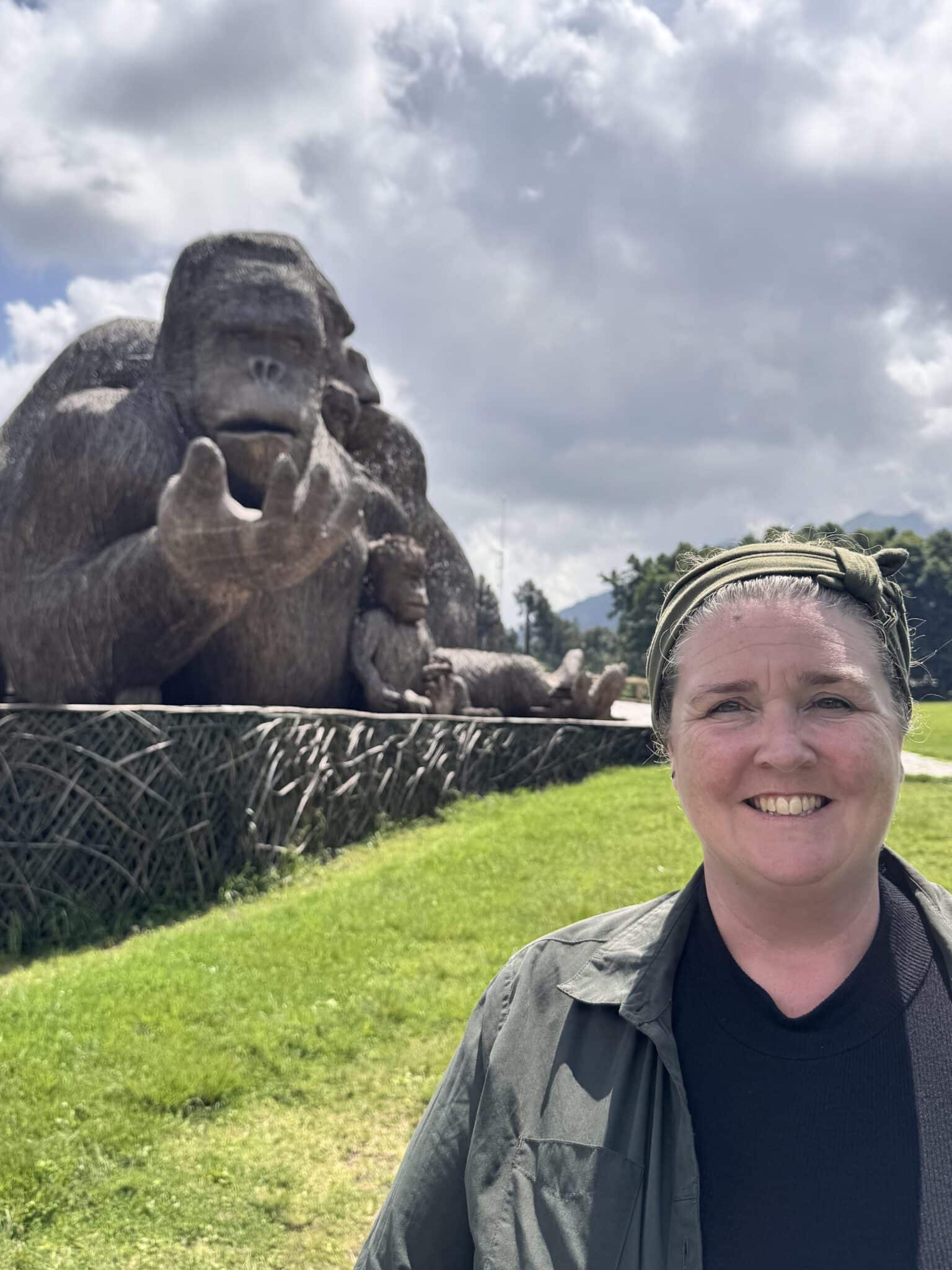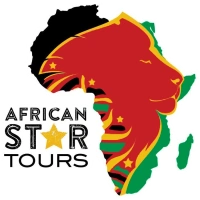Golden Monkey Trekking Rwanda – The Final Primate on My List!
There’s something deeply magical about encountering primates in the wild – the way they move, interact, and look back at you with those thoughtful, intelligent eyes. Over the years, I have been lucky enough to trek with gorillas and chimpanzees in Uganda. But there was one more primate I hadn’t yet met in their natural habitat: golden monkeys. So this past May bank holiday, I set out to change that – with a short but unforgettable trip where my highlight was Golden Monkey Trekking Rwanda Style!


The Day Begins at the Rwanda Development Board Centre
Be warned: it’s an early start, but well worth it. We were up bright and early with our 5.30am alarm in time for a hearty cooked breakfast at our hotel at 6:00am, and ready to be picked up by 6:30am sharp! Our lodge was only about a 15-minute drive from the Rwanda Development Board (RDB) centre, so we arrived just in time for the 7:00am meet-up. If you’re anything like me, coffee before conservation is non-negotiable – and thankfully, the RDB centre delivers: delicious coffee in a great setting.
This is the main hub for all primate activities in Volcanoes National Park, and it’s a smooth, professional, and well-thought-out setup. There are clean toilets (a luxury you’ll never take for granted after a long trek!), free coffee, and even sweet treats to nibble on before you set off. It’s welcoming, efficient, and sets a positive tone for the day ahead – exactly what you want when you’re about to go off into the wilderness.
After check-in, the groups were divided based on the activity booked and assumed fitness level – something RDB handles impressively well. They’re careful to create evenly matched groups, both in size and ability, so no one feels out of place. Once we were grouped and briefed by our fantastic guide, we were off – with a short 10-minute drive to the trailhead. Each group is driven separately, which keeps things personal and streamlined, and means you’re not tripping over other tour groups on the way.
Even with the early alarm, the whole experience felt calm, organised, and exciting – and trust me, that first sip of Rwandan coffee while looking out at the misty volcanoes is a moment you won’t forget.
Trekking Through Farmland to the Forest Edge
From the drop-off point, the trek begins – and while there was some uphill walking, it wasn’t overly strenuous. Thanks to a downpour the day before, the path was a bit slippery in places, but most of the hike is through scenic farmland, winding past local plots of potatoes and pyrethrum flowers with sweeping views of the volcanoes in the distance. Everything was lush, green, and alive with birdsong – it felt like stepping into a postcard (a muddy one, but a postcard nonetheless).
As with most primate treks, trackers are sent ahead early in the morning to locate the monkeys before the group arrives. Golden monkeys are highly active and can move quickly through the trees, so having trackers already on their trail is essential. Our original plan was to visit one of the larger known troops, which reportedly has around 220 individuals – a massive group by primate standards. Golden monkey groups in Volcanoes National Park can range anywhere from 30 to over 200 members, depending on the day and their movements. But in true wildlife fashion, just as we were closing in on the original group, some local dogs began barking nearby and startled the troop, sending them scattering into the forest – a classic plot twist, and a reminder that nature doesn’t run on our schedule. Thankfully, the incredible trackers were quick to adjust and soon led us in a new direction, where we found a second group of about 80 golden monkeys – and honestly, it felt like the perfect number. Big enough to see a wide range of behaviours and social interactions, but small enough that we weren’t overwhelmed trying to take it all in.


An Hour With the Golden Monkeys
Once you’re close to the monkeys, you’re asked to leave behind all bags, food, and drinks – a strict but essential rule. Golden monkeys are inquisitive by nature, and the last thing anyone wants is for them to start associating humans with snacks. It’s all about protecting their natural behaviours and ensuring their environment remains undisturbed. Before heading into the final stretch, everyone is also given a surgical mask – a rule introduced during the COVID pandemic that has thankfully remained. These primates are incredibly susceptible to human illnesses, and even a simple cold could prove fatal. It’s a small but meaningful step in putting their safety first.
After the muddy farmland and thick bamboo undergrowth, we stepped into a small clearing and were suddenly surrounded. Golden monkeys darted above us in the trees and crisscrossed the path right in front of our feet. Their golden-orange coats shimmered in the morning light, contrasting beautifully with the dense green of the bamboo forest. They moved with a mix of agility and playfulness – leaping effortlessly from stalk to stalk, tumbling through the underbrush, and occasionally pausing just long enough to inspect us with wide, intelligent eyes.
One of the things that struck me most during our golden monkey trek was just how expressive and captivating their faces are. As we stood quietly among the bamboo, I found myself completely mesmerised by the way they looked at us—bright, intelligent eyes filled with a mix of curiosity and calm. Their golden-orange fur framed their soft, greyish-blue faces so beautifully that it was impossible not to be drawn in. At times, one would pause mid-chew to give me a long, thoughtful stare—like they were just as intrigued by me as I was by them. Other moments were more playful, with cheeky glances followed by quick leaps back into the trees. There was one younger monkey in particular who sat just a few metres away, head tilted, watching us with such quiet confidence that I almost forgot to lift my camera. That moment of mutual observation, however brief, felt genuinely special—like a tiny, unscripted connection in the middle of the forest.
We spotted big dominant males keeping a watchful eye on their troops, females grooming each other, and young, wide-eyed babies clumsily navigating the bamboo or hitching rides on their mothers’ backs. At one point, I was standing so close I could hear the gentle sound of them chewing on bamboo shoots and the soft rustle of leaves as they moved around us. It didn’t feel intrusive – just quietly extraordinary.
The best part? We were given a full hour with the monkeys. Enough time to observe their rhythms, snap a few photos, and then – my favourite part – put the camera down and just watch. Our group had enough space to spread out, and I chose to hang back for a bit, away from the others, and spend some quiet time with a smaller group who seemed just as curious about me as I was about them. That moment of stillness, with nothing but the sounds of the forest and the monkeys around me, is one I’ll remember for a long time.
It’s incredible how close we were able to get without disturbing them. Golden monkey trekking might not have the same fame as gorilla trekking, but it delivers something just as special: a window into the wild world of these playful, often-overlooked primates – and the rare privilege of being part of their morning routine, even just for an hour.





Porters: Helpful, Friendly & Worth Every Penny
We each hired porters, and I honestly can’t recommend this enough. Sure, golden monkey trekking is traditionally considered much easier than gorilla or chimpanzee trekking – the terrain is generally gentler, the distance shorter, and the pace more relaxed. Because of that, many travellers feel they don’t need a porter for this particular activity. And from a purely practical perspective, that might be true.
But here’s the thing: hiring a porter isn’t just about needing help – it’s about supporting the community that lives alongside this incredible national park. Every porter is a local, and the income they earn goes directly into their hands, helping to support their families and build livelihoods that are tied to conservation, not conflict. It’s a way of making sure that tourism brings benefits to local people, rather than pushing them out or creating barriers. By hiring porters, we help reinforce the idea that protecting wildlife has value – not just for tourists, but for the people who live in the area year-round. It’s a small gesture with a big impact.
That said, ours were genuinely amazing. They helped us across the muddier, more slippery parts of the trail (and saved me from an embarrassing fall more than once!), carried our water and gear – even though we didn’t need much – and were just warm, friendly, and full of good humour throughout. We tipped $20 each, and it felt like the least we could do for the support they gave and the good they’re doing within their community. So whether you think you need one or not – hire the porter. It’s one of the easiest and most direct ways to give back during your time in Rwanda.
Post-Trek Reflections: Gorillas, Statues & a Celebration of Conservation
Although we didn’t trek with the gorillas on this trip—having both been lucky enough to do that in the past—we still felt their presence in a special and meaningful way. After our golden monkey trek, we made a quick stop to visit the giant gorilla statue near the Rwanda Development Board centre, which marks the ceremonial grounds for Kwita Izina, Rwanda’s annual gorilla naming ceremony. It’s a symbolic and powerful space, celebrating not just the country’s rich biodiversity but its unwavering commitment to conservation and community-driven tourism. Standing beneath the towering statue, surrounded by misty volcanoes and hearing stories from local guides about past ceremonies, was a beautiful reminder of how deeply Rwanda values and protects its wildlife.
Kwita Izina—which means “to give a name” in Kinyarwanda—is a uniquely Rwandan tradition, adapted into the world of conservation. Since its launch in 2005, the ceremony has become a national highlight, held every September at the foot of the Virunga volcanoes. During this celebratory week, newly born gorillas are formally given names by park rangers, conservationists, and invited dignitaries—a gesture that not only recognises their individual stories but also helps raise awareness and vital funds for ongoing protection efforts.
Complete with traditional music, dance, and community celebration, Kwita Izina is more than just a naming ceremony; it’s a powerful symbol of Rwanda’s conservation success and a tribute to how deeply the country sees its gorillas—not just as wildlife, but as a cherished part of its national identity and future.



Final Thoughts: Golden Monkeys, Golden Memories
I absolutely loved the golden monkey trek. It felt special – not just because it completed my primate trifecta, but because of the unique energy of these monkeys and the beautiful setting we saw them in. They’re cheeky, curious, and surprisingly photogenic (even if they rarely sit still for long!). Watching them leap through the bamboo with such agility and personality was truly a highlight.
If you’re heading to Rwanda and have already seen the gorillas and chimps – or even if you’re just looking for a shorter, slightly easier primate experience that’s still full of wow moments – golden monkey trekking is 100% worth it. It’s also available in Mgahinga Gorilla National Park in Uganda, making it a fantastic add-on to any trip in the region. It may not get as much attention as its more famous cousins, but trust me – it delivers a wild, joyful, and deeply memorable encounter that’s well worth your time.





